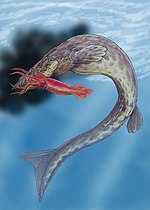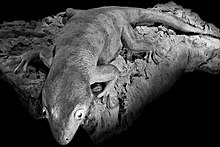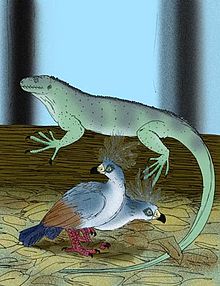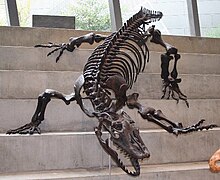List of largest extinct lizards
Appearance
List of largest extinct lizards which are members of the order Squamata.
List
[edit]| Rank | Scientific name | Family | Largest specimen | Length | Mass | Image |
|---|---|---|---|---|---|---|
| 1 | Tylosaurus proriger | Mosasauridae | "FHSM VP-2496" | 14 m (46 ft)[1] | - | |
| 2 | Tylosaurus bernardi | Mosasauridae | 14 m (46 ft) | - | ||
| Tylosaurus proriger | Mosasauridae | FHSM VP-2496 | 14 meters (46 ft)[2] | |||
| 3 | Mosasaurus hoffmani | Mosasauridae | " | 12.9 m (42 ft)[3] | - | |
| 4 | Tylosaurus pembiensis | Mosasauridae | "Bruce" | 12.2 m (40 ft)[citation needed][4] | [citation needed] | 
|
Geckos (Gekkota)
[edit]
- An extinct member of family Diplodactylidae, Kawekaweau or Delcourt's giant gecko (Hoplodactylus delcourti), the largest gecko of all time. It had a snout-vent length of 37 cm (14.6 in), a total length of 60 cm (23.6 in).[5] and a mass of 896.98 g (31.640 oz)[6] The modern representative of same genus is Duvaucel's gecko (Hoplodactylus duvaucelii) also has a large sizes (see list of largest extant lizards).
- Some members of genus Phelsuma are one of the largest extant geckos (see list of largest extant lizards). Although, in the past, day geckos were even more larger. For example, the Rodrigues day gecko (Phelsuma edwardnewtoni) had total length up to 23 cm (9.1 in). The Rodrigues giant day gecko (Phelsuma gigas) was the largest day gecko and second-largest of all geckos (after the kawekaweau), with a length of up to 40 cm (15.74 in) and possibly even 44 cm (17.3 in),[citation needed] and body mass 193.43 g (6.8 oz).[7]
Iguanas (Iguanidae)
[edit]
- The extant members of genus Brachylophus are iguanas small and medium-sized, growing a length of 60–75 cm (24–30 in). Although, in the past there was a much larger member of this family – Brachylophus gibbonsi, reached in length of 1.2 m (3.9 ft),[citation needed] and thus, was 1.8 times longer than its modern relatives. Another very large extinct iguanid, reached even larger – Lapitiguana impensa which had a length of 1.5 m (4.91 ft).[8]
True lizards (Lacertidae)
[edit]- The largest ever lived lacertid, the goliath Tenefire lizard (Gallotia goliath) reached the length of 1.2–1.25 m (3.9–4.1 ft).[9]
Marine lizards (Mosasauridae)
[edit]
- The largest mosasaurs were Mosasaurus, and Tylosaurus, which grew to around 17 m (56 ft) and were projected to weigh up to 20 t (44,000 lb).[10]
Skinks (Scincidae)
[edit]- The Cape Verde giant skink (Chioninia coctei) was a very large skink[11] that grew up to a snout-vent length of 32 cm (13 in)[12] and 56.5 cm (22.2 in) in a total length.[13]
- Another very large extinct skink is the Mauritian giant skink (Leiolopisma mauritiana) which is the largest skink so far discovered; it grew to a snout-vent length of 34 cm (13 in)[14] with a total length of 68 cm (27 in), and according to some information up to 80 cm (31 in)[15]
Monitor lizards (Varanidae)
[edit]
- The prehistoric Australian megalania (Varanus priscus), which may have existed up to 40,000 years ago, is the largest varanid and the largest terrestrial lizard known to exist, but the lack of a complete skeleton has resulted in a wide range of size estimates. Molnar's 2004 assessment resulted in an average weight of 320 kg (710 lb) and length of 4.5 m (15 ft), and a maximum of 1,940 kg (4,280 lb) at 7 m (23 ft) in length, which is toward the high end of the early estimates.[16] However, a 2009 study estimated megalania at 5.5 m (18 ft) and 575 kg (1,268 lb).[17]
- Ever species fossil Saniwa measured 1.3 to 2.1 m (4.3 to 6.9 ft).[18][19]
- Palaeosaniwa was roughly comparable to a large monitor lizard (Varanidae) in size. Measuring around 3–3.5 m (9.8–11.5 ft) in length,[20][21] it is among the largest terrestrial lizards known from the Mesozoic era. Later study shows estimation with snout–vent length about 85 centimetres (33 in) for Maastrichtian species.[22] Asprosaurus may compete with Palaeosaniwa in size.[23] Another large Mesozoic varanoid lizard was Chianghsia with snout-vent length of over 1 m (3 ft 3 in).[24]
See also
[edit]References
[edit]- ^ Everhart, Michael J. (2017). Oceans of Kansas: a natural history of the western interior sea. Life of the past (Second ed.). Bloomington, Indiana: Indiana University Press. ISBN 978-0-253-02632-3. OCLC 962233805.
- ^ Everhart, Michael J. (2017). Oceans of Kansas: a natural history of the western interior sea. Life of the past (2nd ed.). Bloomington: Indiana university press. ISBN 978-0-253-02632-3.
- ^ Gayford, Joel H.; Engelman, Russell K.; Sternes, Phillip C.; Itano, Wayne M.; Bazzi, Mohamad; Collareta, Alberto; Salas-Gismondi, Rodolfo; Shimada, Kenshu (September 2024). "Cautionary tales on the use of proxies to estimate body size and form of extinct animals". Ecology and Evolution. 14 (9): e70218. doi:10.1002/ece3.70218. ISSN 2045-7758. PMC 11368419. PMID 39224151.
- ^ Lindgren, J. (2005). "The first record of Hainosaurus (Reptilia: Mosasauridae) from Sweden". Journal of Paleontology. 79 (6): 1157–1165. doi:10.1666/0022-3360(2005)079[1157:tfrohr]2.0.co;2.
- ^ Wilson, K.-J. (2004). Flight of the Huia: Ecology and Conservation of New Zealand's Frogs, Reptiles, Birds and Mammals. Canterbury University Press. ISBN 0-908812-52-3. OCLC 937349394.
- ^ "Delcourt's giant Gecko - Encyclopedia of Life". Eol.org.
- ^ "Rodrigues giant day gecko – Encyclopedia of Life". Eol.org.
- ^ Pregill, G. K.; Worthy, T. H. (March 2003). "A New Iguanid Lizard (Squamata, Iguanidae) from the Late Quaternary of Fiji, Southwest Pacific". Herpetologica. 59 (1). The Herpetologists' League: 57–67. doi:10.1655/0018-0831(2003)059[0057:ANILSI]2.0.CO;2. S2CID 85804786.
- ^ Martin, A. (2006). 3. Aportaciones de D. Telesforo Bravo al conocimiento de la fauna de vertebrados terrestres de las islas Canarias (PDF). Instituto de Estudios Hispánicos de Canarias. pp. 71–92. ISBN 84-611-0482-X.
{{cite book}}:|work=ignored (help) - ^ Science & Nature – Sea Monsters – Fact File: Giant Mosasaur. BBC (2005-08-26)
- ^ "Macroscincus coctei in the "Ilhéu Razo" (Cape Verde) del Dr. Franco Andreone". Caboverde.com.
- ^ Greer AE [in French] (1976). "On the evolution of the giant Cape Verde scincid lizard Macroscincus coctei ". Journal of Natural History. 10 (6): 691–712. Bibcode:1976JNatH..10..691G. doi:10.1080/00222937600770551.
- ^ Luís M.P. Ceríaco (2012). "From Cape Verde to the Netherlands via Portugal and France: the journey of an early specimen of the giant skink Chioninia coctei (Duméril & Bibron, 1839)". Zoologia Caboverdiana: 74–81. ISSN 2074-5737.
- ^ James Evans (2021). Lizards of the World: A Guide to Every Family. Princeton University Press. ISBN 978-1-78240-957-1.
- ^ "Island Weirdness #26 – The Mauritian Giant Skink". Nixillustration.com. Retrieved 19 May 2022.
- ^ Molnar, R. E. (2004). "The Long and Honorable History of Monitors and Their Kin". Varanoid Lizards of the World. Indiana University Press. p. 588. ISBN 978-0-253-34366-6.
- ^ Fry, Bryan G.; Wroe, Stephen; Teeuwisse, Wouter; van Osch, Matthias J. P.; Moreno, Karen; Ingle, Janette; McHenry, Colin; Ferrara, Toni; Clausen, Phillip; Scheib, Holger; Winter, Kelly L.; Greisman, Laura; Roelants, Kim; van der Weerd, Louise; Clemente, Christofer J. (2009-06-02). "A central role for venom in predation by Varanus komodoensis (Komodo Dragon) and the extinct giant Varanus ( Megalania ) priscus". Proceedings of the National Academy of Sciences. 106 (22): 8969–8974. doi:10.1073/pnas.0810883106. ISSN 0027-8424. PMC 2690028.
- ^ Pianka, Eric R.; King, Dennis; King, Ruth Allen (2004). Varanoid Lizards of the World. Indiana University Press. pp. 33 to 38. ISBN 978-0253343666.
- ^ Rieppel, O.; Grande, L. (July 2007). "The anatomy of the fossil varanid lizard Saniwa ensidens Leidy, 1870, based on a newly discovered complete skeleton". Journal of Paleontology. 81 (4): 643–665. doi:10.1666/pleo0022-3360(2007)081[0643:TAOTFV]2.0.CO;2. S2CID 130800851.
- ^ Archibald, J. David (2011). Extinction and Radiation: How the Fall of Dinosaurs Led to the Rise of Mammals. JHU Press. p. 43. ISBN 9780801898051.
- ^ "Palaeosaniwa" from James Gurney: The World of Dinosaurs
- ^ Longrich, Nicholas R.; Bhullar, Bhart-Anjan S.; Gauthier, Jacques A. (2012-12-26). "Mass extinction of lizards and snakes at the Cretaceous–Paleogene boundary". Proceedings of the National Academy of Sciences. 109 (52): 21396–21401. Bibcode:2012PNAS..10921396L. doi:10.1073/pnas.1211526110. ISSN 0027-8424. PMC 3535637. PMID 23236177.
- ^ The first lizard fossil (Reptilia: Squamata) from the Mesozoic of South Korea. Cretaceous Research 55:292–302. - J.-Y. Park, S. E. Evans & M. Huh - 2015.
- ^ Mo, J. Y.; Xu, X.; Evans, S. E. (2012). "A large predatory lizard (Platynota, Squamata) from the Late Cretaceous of South China". Journal of Systematic Palaeontology. 10 (2): 333. Bibcode:2012JSPal..10..333M. doi:10.1080/14772019.2011.588254. S2CID 85682211.
